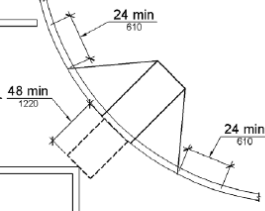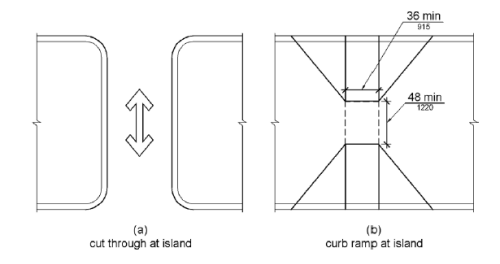You provide the
information; we'll check your compliance and give you the results Instantly!
Checking the ADA curb ramp requirements is fairly easy when you use and run an
ADA compliance check at AdaResults.com. Minimal tools and requires no knowledge
or understanding of the ADA codes; you just take a few measurements, answer a
couple of questions and get you ADA results instantly!
Ground Rules
There are some important points you should understand to perform the survey and
produce a quality ADA compliance report.
- The
printable survey form
will have more questions at the time of inspection than the online form
- When you provide the information to the online form be sure that you are
providing the correct data from the proper part of the survey form.
- Using a slope meter is recommended, the display should be set to output percentage
Tools you will need
Curb Ramp
Curb Ramp Type
To get the correct results from your ADA inspection of you curb ramp you will
need to identify the type of curb ramp that it is. Choose one of the three
listed, the illustrations below will help you identify the correct type of curb
ramp.
Side Walk Ramps 

Corner or Diagonal Ramp

Built-Up Curn Ramp

RRamps at Island

Curb ramp has a top landing
Some curb ramp may not have a top landing, this occurs for various reasons; be
sure to check this box otherwise you may get incorrect results upon running the
compliance check.
Transitions are smooth where ramp joins sidewalk, street or gutters
This question will be answered by you doing a visual inspection of the area
leading to and off of the ramp. Check for changes in level such as a lip or
raised edge where the ramp meets the gutter or roadway, or where the top of the
ramp meets the landing.
Curb ramp is at marked crossing
If the curb ramp is at a marked crossing or crosswalk you should select the
check box and then proceed to answer the ramp wholly contained within the marked
crossing; the ramp itself must be within the crossing.
Type of curb ramp sides
Curb ramp side are typically flared or have returned corners or edges that flow
in the direction of pedestrian travel, use the image illustrated here to help
make the correct selection.


Ramp Details
Ramp Width
The ramp width is measured across from edge to edge of the running slope, the
side flares or curbs should not be included in the measurement.
Ramp Slope
Ramp slope is measured in the direction of travel, so place your slope meter
length-wise in the directional of travel to get an accurate reading.
Cross Slope
Cross slope is measured across the running slope of the ramp; the length of the
slope meter should be from side to side.
Side Flare Slope
If your ramp has side flares you need to get a slope reading and record it. The
slope of the side flares should be measured as if you were going up the side
flare; take reading at slightly different angles and record the highest reading.
If the curb ramp is a corner type you may need to indicate the length of the
curb segment on each side of the curb ramp.
Returned curb edges are in direction of pedestrian travel
If your ramp side are returned rather than flared you will need to mark the
checkbox if the returned curbs are in the direction of pedestrian traffic,
meaning that your path can continue without making an immediate turn.
Top and Bottom Landing
Top Landing Length
If your curb ramp has a top landing you will need to provide the length of the
top landing no the nearest edge of obstruction such as a wall or planter. The
measurement is taken from the edge of the ramp where it transitions to the top
landing, to the nearest obstruction.
Top Landing Width
If your curb ramp has a top landing you will need to provide this width; the
width of the top landing should be at least as wide as the ramp itself,
excluding side flares and curbs.
Top Landing Slope/Cross Slope
The top landing slope should be measured in multiple location and direction to
ensure that the landing meets the minimum slope requirement.
Bottom Landing Length
Measure the length of the bottom landing starting at the transition from the
ramp to the roadway or path; you should need to measure more than 60 inches,
then indicate if the landing is within marked crossings by selecting the check
box.
Bottom Landing Slope/Cross Slope
The bottom landing slope should be measured in multiple location and direction
to ensure that the landing meets the minimum slope requirement.